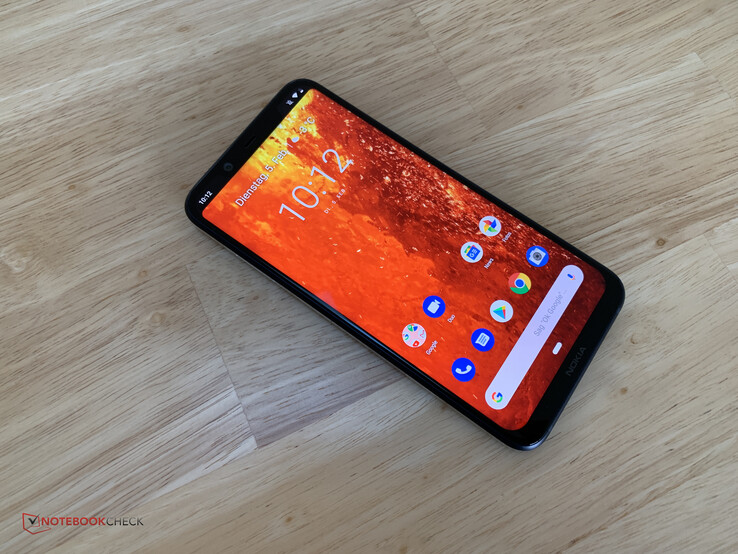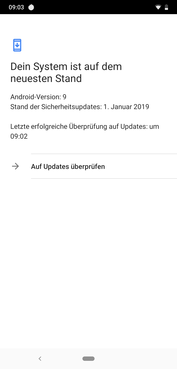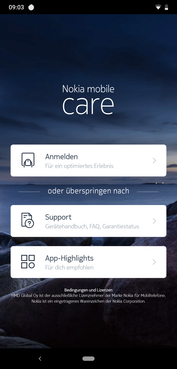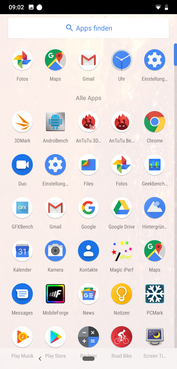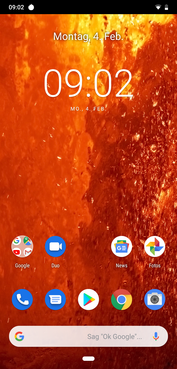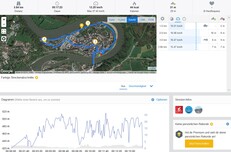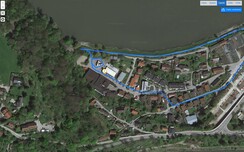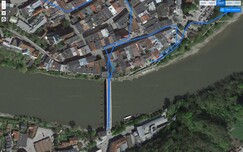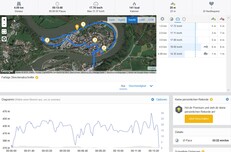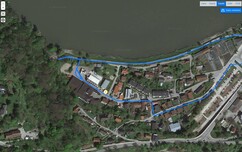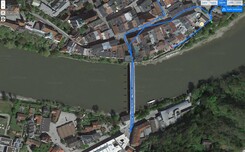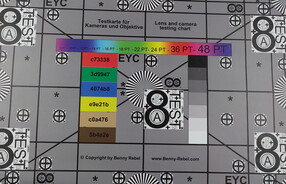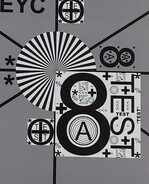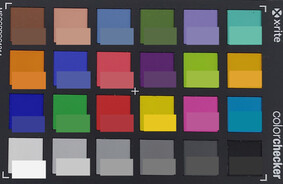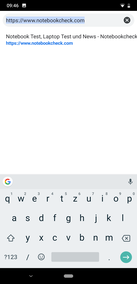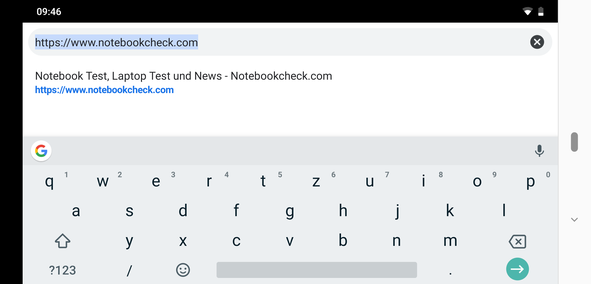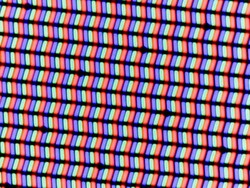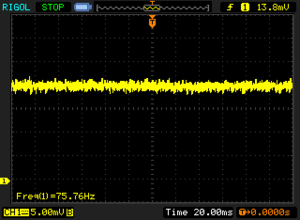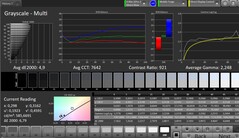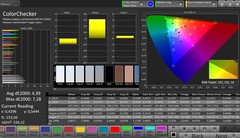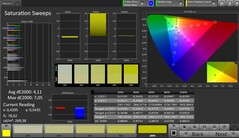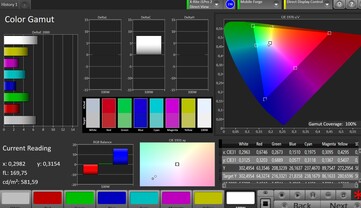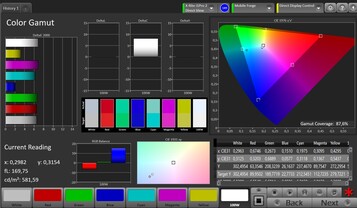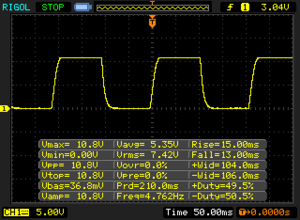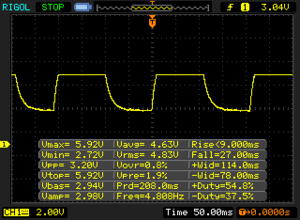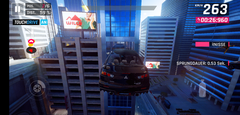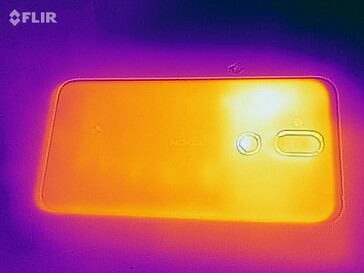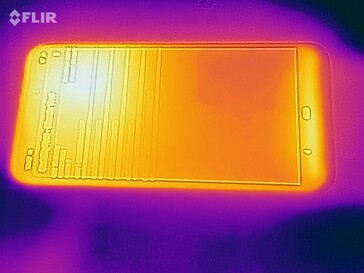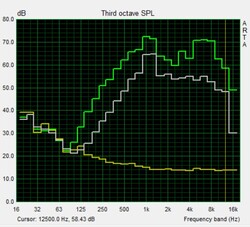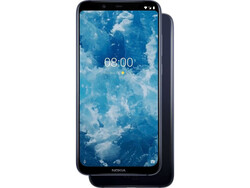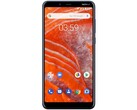Nokia 8.1 Smartphone Review
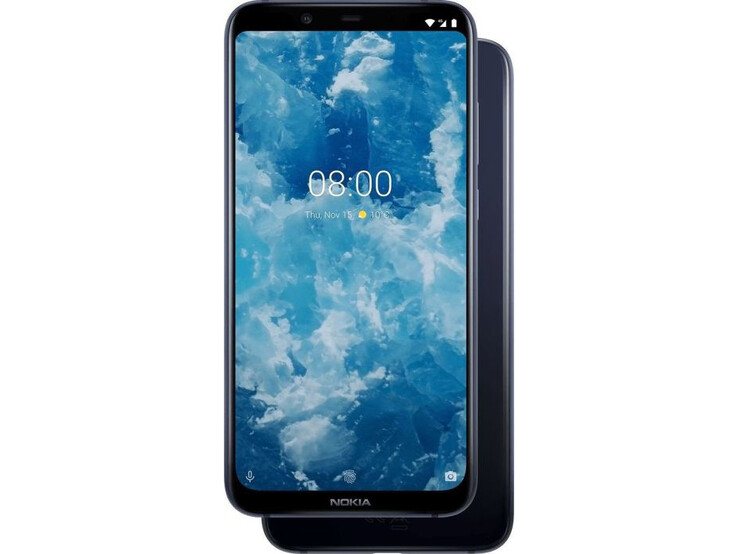
HMD Global markets the Nokia 8.1 as an upper midrange smartphone and has given the device a modern glass and metal design. The 8.1 has Zeiss branded dual rear-facing cameras and runs Android One, which Google should regularly provide with updates. The Finnish company positions the 8.1 below the Nokia 8 and has equipped the former with a Qualcomm Snapdragon 710 SoC, which is not as powerful as the Snapdragon 835 found in the Nokia 8. The 8.1 retails at €399 ($450), which is correspondingly much cheaper than what HMD Global initially charged for the Nokia 8.
We have chosen to compare the Nokia 8.1 against other comparably priced midrange smartphones and some of last year’s flagships that have now reduced in price. Our comparison devices will include the Nokia 8 Sirocco, the Samsung Galaxy A9 (2018), the Sony Xperia XZ2 and the Xiaomi Mi Mix 2S.
Case
The Nokia 8.1 has a simple design, but that should not detract from its special features. The back is, like many current smartphones, made of glass, while the metal frame has a matte finish that catches the light. The rear camera housing and fingerprint reader have silver accents too, which contrasts nicely with the glass back of our black review unit. In short, the materials used, and the finish of the case makes the Nokia 8.1 look and feel like a premium smartphone. HMD Global currently sells the Nokia 8.1 in either, blue, black or copper.
The Nokia 8.1 is lighter than all but the Nokia 8 Sirocco of our comparison devices and is almost 20 g (~0.7 oz) lighter than the Sony Xperia XZ2. Our test unit also measures 8 mm (~0.3 in) thick, which is rather slim, but its rear-facing camera protrudes a few millimetres from its case, so the device never lies flat on a table.
Our review device is well-built too. We could not get the display to warp regardless of how hard we pressed on the screen or the back case. Moreover, we could only twist the case slightly, although the case does creak when we try to bend it.
Connectivity
The Nokia 8.1 has 64 GB of internal storage and 4 GB of RAM, which were commonplace for flagships released in 2017 or 2018, just as devices such as the Galaxy S9 and the Xperia XZ2 demonstrate. Standards have moved in 2019 though, and put Nokia 8.1 firmly in the midrange bracket in this regard. Some OEMs have even started equipping their midrange devices with 128 GB of storage and 6 GB of RAM, but 64 GB and 4 GB should still be plenty for most people in our opinion.
HMD Global has equipped the Nokia 8.1 with NFC too for use with services such as Google Pay and a Bluetooth 5.0 modem.
The Nokia 8.1 has two SIM slots and supports up to 400 GB microSD cards should you need more storage. However, the second SIM slot is also the microSD card slot, so you must compromise between dual-SIM functionality and microSD card expansion, which is unfortunate.
Software
The Nokia 8.1 is Android One certified, which means that Google supplies updates with no OEM interface. The idea behind Android One is to provide devices with more regular system and security updates while reducing the amount of fragmentation within the Android ecosystem.
The Nokia 8.1 ships with Android 9 Pie and Google has committed to delivering two major system updates, which should see the device eventually running Android 11. The company had also pushed out January 1, 2019 security patches to our review unit at the time of testing, which were the most recent patches available at the time.
The device also supports multiple user accounts and has hardly any third-party apps pre-installed. Our review unit only has the Nokia support app other than Google software, which can help people get quickly acclimatised to their device should they be unfamiliar with Android.
Communication & GPS
The Nokia 8.1 supports up to IEEE 802.11 ac Wi-Fi and can connect to either 2.4 GHz or 5 GHz networks. Our review unit finished in the midfield of our iperf3 Client comparison tables and averaged around 300 MBit/s in both tests that we conducted. These speeds are typical of modern midrange smartphones but are now over 50% slower than modern flagships such as the Xperia XZ2 and the Mi Mix 2S.
The Nokia 8.1 has limited LTE support though. The device utilises just 6 LTE bands, which is the bare minimum for use in areas such as central Europe, but globetrotters will struggle to connect to LTE networks in many countries. Our review unit maintained decent mobile network reception in urban environments though, so most people should have no problems with connecting to an LTE network if you are in a country that uses one of the 6 LTE bands that the Nokia 8.1 supports.
| Networking | |
| iperf3 transmit AX12 | |
| Xiaomi Mi Mix 2S | |
| Sony Xperia XZ2 | |
| Nokia 8 Sirocco | |
| Nokia 8.1 | |
| Samsung Galaxy A9 2018 | |
| iperf3 receive AX12 | |
| Sony Xperia XZ2 | |
| Xiaomi Mi Mix 2S | |
| Samsung Galaxy A9 2018 | |
| Nokia 8.1 | |
| Nokia 8 Sirocco | |
Our test device can also locate us with up to 14 metres (~46 ft) accuracy indoors whether we stand next to a window or in the middle of a room. This may not sound that accurate, but many midrange smartphones have been unable to locate us in identical tests. Predictably, GPS accuracy improved when we tested the device outside, with the Nokia 8.1 able to maintain a satellite fix with up to 4 metres (~13 ft) accuracy.
Google Maps also found our location with an accuracy of up to a few meters after a few seconds. The compass worked reliably throughout testing.
We also took the Nokia 8.1 on a bike ride to measures its GPS accuracy against the Garmin Edge 520, a professional navigation device. Our test device deviated by 210 metres (~230 yd) from the 4.09 km (~2.5 mi) route that the Garmin plotted, but that is not the whole story. The Nokia 8.1 occasionally struggled to record the route that we took accurately, but it did a better job than the Garmin during the looped section of our bike ride. However, sharp turns often caught the Nokia 8.1 unawares, which then caused it to cut corners to keep up with us.
Overall, the Nokia 8.1 has decent GPS accuracy for a midrange smartphone and should be good enough for most general navigation tasks. However, we would recommend using a different device if you need precise location data.
Telephone Features & Call Quality
The Nokia 8.1 uses the Google suite of apps for handling calls, contacts and messages. The apps work just as well as they do on other devices that we have tested. The device supports voice over LTE (VoLTE) and voice over Wi-Fi (VoWiFi), but your carrier must provision the Nokia 8.1 on its network before either technology will work.
Our review unit has decent call quality and reproduced our call partner’s voice loudly throughout our tests, while it also did a good job at filtering out background noise. In short, you should always be able to hear who you are talking to, but their voice may not always sound completely clear.
By contrast, the microphone reproduced our voice well, although it performed worse when we tried making a call over speakerphone. Quiet voices are practically unintelligible, while loud voices sound too distorted for our liking.
Cameras
HMD Global has equipped the Nokia 8.1 with a 20 MP front-facing camera, which is an unusually high resolution sensor for a midrange smartphone. The camera can only produce software-based bokeh effects as it is not supported by a depth-of-field sensor, and the default camera app does not include any augmented reality (AR) filters as we have seen with the Apple iPhone XS or the Samsung Galaxy S9.
The Nokia 8.1 also has Zeiss branded dual rear-facing cameras, the main sensor of which is a 12 MP camera that supports optical image stabilisation (OIS) and has an f/1.8 aperture. The primary camera is supported by a 13 MP sensor that helps our review unit create convincing bokeh effect photos, an example of which we have included below. Pictures taken in the standard mode look more detailed in our opinion and capture objects more sharply than in the bokeh effect mode.
The Nokia 8.1 also takes considerably wider-angle photos than the iPhone XS Max, which is most noticeable when shooting landscapes like in scene 2. Our test device takes more detailed pictures than the OnePlus 5T, for example, but our comparison devices tend to expose scenes better than the Nokia 8.1 can. This difference became particularly apparent during our low-light photography tests as can be seen in scene 3.
The rear-facing camera can record videos in up to 4K at 30 FPS. The image quality is good, but it cannot adjust exposure smoothly, which is disappointing for a $450 smartphone. By contrast, our review unit recorded audio cleanly, which is not always the case with midrange smartphones.
We also subjected the Nokia 8.1 to further camera tests under controlled lighting conditions. Our review unit reproduced our test chart well and did a good job at delineating black text from blocks of colour. The 12 MP cannot maintain contrast levels across the entire chart though, with there being a noticeable reduction in the top-left hand corner of the image.
The Nokia 8.1 also reproduces colours accurately, as demonstrated by the ColorChecker Passport chart below. However, the main camera replicates white and grey tones too darkly.
Accessories & Warranty
HMD Global includes an 18-W charger and a USB-C cable in the box, along with a set of headphones. The latter sits well in our ears and produce listenable sound, but music lacks depth, which makes everything sound too tinny for our liking.
The Nokia 8.1 comes with 24 months manufacturer’s warranty. Please see our Guarantees, Return policies and Warranties article for more country-specific information.
Input Devices & Operation
The Nokia 8.1 comes with Google GBoard pre-installed as its default keyboard, which works just as well as it does on other devices that we have tested. The touchscreen worked flawlessly throughout our tests and is sensitive into the corners of the display. The screen has a smooth finish that feels premium too and is easy to perform swiping gestures on.
HMD Global has also included a fingerprint scanner that is located on the back of the device. The fingerprint reader on our review unit unlocked the device quickly throughout our tests without any issues. The Nokia 8.1 does not currently support facial authentication, but HMD Global has subsequently added this feature to its other devices in an update, so the company may do this again at some point.
The Nokia 8.1 also supports numerous gestures and shortcuts that can trigger a variety of functions. Double pressing the power button launches the camera while flipping over the device rejects an incoming call. You can also bring the notification shade down by swiping downwards on the fingerprint sensor.
Display
The Nokia 8.1 has a 6.18-inch display that operates natively at 2,246x1,080. The screen has a large notch too, which houses the earpiece, the front-facing camera and the ambient light sensor. The skewed aspect ratio causes content that was shot in 16:9 to appear letterboxed, but that is the case with most modern smartphones that do not have 16:9 aspect ratio displays.
Our review unit achieved an average maximum brightness of 547 cd/m², according to X-Rite i1Pro 2, which is much brighter than the display in the Mi Mix 2S, but is around 16% darker than the Xperia XZ2. The display is also 92% evenly lit, which is on par with the average of our comparison devices.
| |||||||||||||||||||||||||
Brightness Distribution: 92 %
Center on Battery: 567 cd/m²
Contrast: 930:1 (Black: 0.61 cd/m²)
ΔE ColorChecker Calman: 4.39 | ∀{0.5-29.43 Ø4.78}
ΔE Greyscale Calman: 4.9 | ∀{0.09-98 Ø5}
100% sRGB (Calman 2D)
Gamma: 2.248
CCT: 7642 K
| Nokia 8.1 IPS, 2246x1080, 6.2" | Samsung Galaxy A9 2018 OLED, 2220x1080, 6.3" | Xiaomi Mi Mix 2S IPS, 2160x1080, 6" | Sony Xperia XZ2 IPS, 2160x1080, 5.7" | Nokia 8 Sirocco P-OLED, 2560x1440, 5.5" | |
|---|---|---|---|---|---|
| Screen | 25% | 4% | 35% | -5% | |
| Brightness middle (cd/m²) | 567 | 553 -2% | 492 -13% | 630 11% | 576 2% |
| Brightness (cd/m²) | 547 | 553 1% | 463 -15% | 632 16% | 597 9% |
| Brightness Distribution (%) | 92 | 96 4% | 90 -2% | 96 4% | 85 -8% |
| Black Level * (cd/m²) | 0.61 | 0.59 3% | 0.44 28% | ||
| Contrast (:1) | 930 | 834 -10% | 1432 54% | ||
| Colorchecker dE 2000 * | 4.39 | 2.2 50% | 2.4 45% | 1.5 66% | 5 -14% |
| Colorchecker dE 2000 max. * | 7.28 | 5.1 30% | 6.2 15% | 4.3 41% | 8 -10% |
| Greyscale dE 2000 * | 4.9 | 1.7 65% | 4.5 8% | 2.1 57% | 5.4 -10% |
| Gamma | 2.248 98% | 2.06 107% | 2.25 98% | 2.17 101% | 2.3 96% |
| CCT | 7642 85% | 6434 101% | 6395 102% | 6513 100% | 7730 84% |
* ... smaller is better
Screen Flickering / PWM (Pulse-Width Modulation)
| Screen flickering / PWM detected | 75.8 Hz | ≤ 10 % brightness setting | |
The display backlight flickers at 75.8 Hz (worst case, e.g., utilizing PWM) Flickering detected at a brightness setting of 10 % and below. There should be no flickering or PWM above this brightness setting. The frequency of 75.8 Hz is very low, so the flickering may cause eyestrain and headaches after extended use. In comparison: 53 % of all tested devices do not use PWM to dim the display. If PWM was detected, an average of 8111 (minimum: 5 - maximum: 343500) Hz was measured. | |||
Disappointingly, the Nokia 8.1 has a 0.61 cd/m² black value, which is frankly too high and results in an underwhelming 930:1 contrast ratio. Our test device has a more vibrant display than the Mi Mix 2S, but it is resoundingly beaten by the Xperia XZ2.
We also subjected our review unit to display tests with a spectrophotometer and CalMAN analysis software. Our tests determined that the display has a slight blue tint to it and its average DeltaE deviations are above ideal values. Furthermore, our comparison devices offer more colour accurate displays than the Nokia 8.1.
HMD Global has included three colour modes and a dynamic mode that automatically selects the best colour preset depending on what is being displayed onscreen. We tested the Nokia 8.1 with its Vivid mode selected, while its Cinema and Basic modes offer a warmer white balance. The Cinema mode also reproduces colours more vividly than the Basic mode does.
Our test device completely covers the sRGB colour space, according to CalMAN, although its results are not completely accurate, so we would recommend taking them with a pinch of salt. It is a shame that HMD Global did not include an option to adjust the white balance manually, but there are numerous third-party apps that are available on the Google Play Store, which could do this should your display also suffer from a blue tint like the one in our review unit does.
Display Response Times
| ↔ Response Time Black to White | ||
|---|---|---|
| 28 ms ... rise ↗ and fall ↘ combined | ↗ 15 ms rise | |
| ↘ 13 ms fall | ||
| The screen shows relatively slow response rates in our tests and may be too slow for gamers. In comparison, all tested devices range from 0.1 (minimum) to 240 (maximum) ms. » 70 % of all devices are better. This means that the measured response time is worse than the average of all tested devices (20.2 ms). | ||
| ↔ Response Time 50% Grey to 80% Grey | ||
| 36 ms ... rise ↗ and fall ↘ combined | ↗ 9 ms rise | |
| ↘ 27 ms fall | ||
| The screen shows slow response rates in our tests and will be unsatisfactory for gamers. In comparison, all tested devices range from 0.165 (minimum) to 636 (maximum) ms. » 49 % of all devices are better. This means that the measured response time is worse than the average of all tested devices (31.6 ms). | ||
You should have no issues with using the Nokia 8.1 outside on cloudy days. However, reflections will overwhelm the display in direct sunlight as demonstrated in the pictures below. Hence, we would suggest finding a shady spot where possible if you must use your device outside on a sunny day.
The Nokia 8.1 has good viewing angles too, but the screen suffers from slight brightness shifts at acute viewing angles. These look more pronounced in our photos than they do to our eyes, so we doubt that they will be an issue for most people in daily use. In short, the Nokia 8.1 should remain readable from almost any angle.
Performance
The Nokia 8.1 is the first smartphone that we have tested, which has a Qualcomm Snapdragon 710 SoC. The Snapdragon 710 is an upper midrange chip that Qualcomm manufactures on a 10 nm FinFET process, and which should be more energy efficient than its predecessors. The SoC delivers considerably better single-core performance than chips such as the Snapdragon 660 too, but there is hardly any difference in multi-core performance between generations. Perhaps predictably, high-end SoCs such as the Snapdragon 835 and Snapdragon 845 achieve higher scores in synthetic benchmarks. However, the former only scored around 15% more in Geekbench 4.3, while the Snapdragon 710 even outscored the Snapdragon 835 in some 3DMark benchmarks.
The Snapdragon 710 integrates a Qualcomm Adreno 616 GPU, which supports all modern graphics APIs, and should be future proofed for the next few years. The Adreno 616 should deliver around 30% better performance than its predecessors.
| PCMark for Android | |
| Work performance score (sort by value) | |
| Nokia 8.1 | |
| Samsung Galaxy A9 2018 | |
| Xiaomi Mi Mix 2S | |
| Sony Xperia XZ2 | |
| Nokia 8 Sirocco | |
| Average Qualcomm Snapdragon 710 (7041 - 9345, n=6) | |
| Work 2.0 performance score (sort by value) | |
| Nokia 8.1 | |
| Samsung Galaxy A9 2018 | |
| Xiaomi Mi Mix 2S | |
| Sony Xperia XZ2 | |
| Nokia 8 Sirocco | |
| Average Qualcomm Snapdragon 710 (6453 - 7460, n=6) | |
| GFXBench 3.1 | |
| on screen Manhattan ES 3.1 Onscreen (sort by value) | |
| Nokia 8.1 | |
| Samsung Galaxy A9 2018 | |
| Xiaomi Mi Mix 2S | |
| Sony Xperia XZ2 | |
| Nokia 8 Sirocco | |
| Average Qualcomm Snapdragon 710 (19 - 30, n=6) | |
| Average of class Smartphone (11 - 166, n=158, last 2 years) | |
| 1920x1080 Manhattan ES 3.1 Offscreen (sort by value) | |
| Nokia 8.1 | |
| Samsung Galaxy A9 2018 | |
| Xiaomi Mi Mix 2S | |
| Sony Xperia XZ2 | |
| Nokia 8 Sirocco | |
| Average Qualcomm Snapdragon 710 (23 - 23, n=6) | |
| Average of class Smartphone (8.4 - 413, n=158, last 2 years) | |
| Basemark GPU 1.1 | |
| 1920x1080 Vulkan Medium Offscreen (sort by value) | |
| Nokia 8.1 | |
| Average Qualcomm Snapdragon 710 (11.4 - 13, n=3) | |
| Vulkan Medium Native (sort by value) | |
| Nokia 8.1 | |
| Average Qualcomm Snapdragon 710 (10.1 - 12.1, n=2) | |
| 1920x1080 OpenGL Medium Offscreen (sort by value) | |
| Nokia 8.1 | |
| Average Qualcomm Snapdragon 710 (14.3 - 15.5, n=3) | |
| AnTuTu v7 - Total Score (sort by value) | |
| Nokia 8.1 | |
| Samsung Galaxy A9 2018 | |
| Xiaomi Mi Mix 2S | |
| Sony Xperia XZ2 | |
| Nokia 8 Sirocco | |
| Average Qualcomm Snapdragon 710 (155113 - 169262, n=4) | |
| AnTuTu v6 - Total Score (sort by value) | |
| Nokia 8.1 | |
| Samsung Galaxy A9 2018 | |
| Xiaomi Mi Mix 2S | |
| Sony Xperia XZ2 | |
| Nokia 8 Sirocco | |
| Average Qualcomm Snapdragon 710 (135848 - 137693, n=3) | |
| VRMark - Amber Room (sort by value) | |
| Nokia 8.1 | |
| Average Qualcomm Snapdragon 710 (1681 - 1708, n=3) | |
| Basemark ES 3.1 / Metal - offscreen Overall Score (sort by value) | |
| Nokia 8.1 | |
| Average Qualcomm Snapdragon 710 (479 - 488, n=3) | |
| Average of class Smartphone (205 - 7731, n=36, last 2 years) | |
The Nokia 8.1 also performed well in browser benchmarks and traded blows with our more powerful comparison devices in our comparison tables.
Subjectively, websites load quickly on our review unit, as do media content such as pictures. The difference in browser performance is also negligible between the Nokia 8.1 and devices such as the Mi Mix 2S; such is the power of the Snapdragon 710 SoC.
| JetStream 1.1 - Total Score | |
| Sony Xperia XZ2 (Chrome 65) | |
| Xiaomi Mi Mix 2S (Chrome 66.0.3359.158) | |
| Nokia 8.1 (Chrome 71) | |
| Nokia 8 Sirocco (Chrome 66) | |
| Average Qualcomm Snapdragon 710 (50.5 - 66.6, n=6) | |
| Samsung Galaxy A9 2018 (Chrome 70) | |
| Octane V2 - Total Score | |
| Average of class Smartphone (2228 - 121337, n=201, last 2 years) | |
| Sony Xperia XZ2 (Chrome 65) | |
| Xiaomi Mi Mix 2S (Chrome 66.0.3359.158) | |
| Nokia 8.1 (Chrome 71) | |
| Average Qualcomm Snapdragon 710 (9771 - 12802, n=6) | |
| Nokia 8 Sirocco (Chrome 66) | |
| Samsung Galaxy A9 2018 (Chrome 70) | |
| Mozilla Kraken 1.1 - Total | |
| Nokia 8 Sirocco (Chrome 66) | |
| Samsung Galaxy A9 2018 (Chrome 70) | |
| Average Qualcomm Snapdragon 710 (3035 - 3800, n=6) | |
| Nokia 8.1 (Chrome 71) | |
| Xiaomi Mi Mix 2S (Chrome 66.0.3359.158) | |
| Sony Xperia XZ2 (Chrome 65) | |
| Average of class Smartphone (257 - 28190, n=156, last 2 years) | |
| WebXPRT 3 - Overall | |
| Average of class Smartphone (38 - 380, n=35, last 2 years) | |
| Xiaomi Mi Mix 2S | |
| Nokia 8 Sirocco (Chrome 66) | |
| Nokia 8.1 (Chrome 71) | |
| Average Qualcomm Snapdragon 710 (57 - 72, n=6) | |
| Samsung Galaxy A9 2018 (Chrome 70) | |
| Sony Xperia XZ2 | |
| WebXPRT 2015 - Overall | |
| Sony Xperia XZ2 (Chrome 65) | |
| Xiaomi Mi Mix 2S (Chrome 66.0.3359.158) | |
| Nokia 8.1 (Chrome 71) | |
| Nokia 8 Sirocco (Chrome 66) | |
| Samsung Galaxy A9 2018 (Chrome 70) | |
| Average Qualcomm Snapdragon 710 (166 - 209, n=6) | |
* ... smaller is better
We tested the speed of our review unit’s microSD card reader with our reference card, the Toshiba Exceria Pro M501. The Nokia 8.1 will win no awards here, but it does achieve above average read and write speeds. It is worth keeping in mind that the device does not support the exFAT file system, which limits the Nokia 8.1 to only being able to read files that are smaller than 4 GB from expandable memory.
The internal memory storage is considerably slower than our comparison devices though. HMD Global has equipped the Nokia 8.1 with eMMC flash storage, which is much slower than the UFS 2.1 memory in our comparison devices. The flash memory in our review unit is not necessarily fast by eMMC standards either, which is disappointing.
| Nokia 8.1 | Samsung Galaxy A9 2018 | Xiaomi Mi Mix 2S | Sony Xperia XZ2 | Nokia 8 Sirocco | Average 64 GB eMMC Flash | Average of class Smartphone | |
|---|---|---|---|---|---|---|---|
| AndroBench 3-5 | 46% | 481% | 47% | 119% | 55% | 1577% | |
| Sequential Read 256KB (MB/s) | 279.3 | 426.6 53% | 756 171% | 679 143% | 738 164% | 277 ? -1% | 2223 ? 696% |
| Sequential Write 256KB (MB/s) | 203.8 | 194.6 -5% | 208.1 2% | 198.7 -3% | 211.6 4% | 178.4 ? -12% | 1838 ? 802% |
| Random Read 4KB (MB/s) | 69.9 | 116.8 67% | 135.1 93% | 149.4 114% | 140.7 101% | 60.7 ? -13% | 295 ? 322% |
| Random Write 4KB (MB/s) | 7.3 | 19.79 171% | 128.4 1659% | 17 133% | 22.4 207% | 33.8 ? 363% | 335 ? 4489% |
| Sequential Read 256KB SDCard (MB/s) | 84.7 ? | 73.7 ? -13% | 34.25 ? -60% | 77.4 ? -9% | |||
| Sequential Write 256KB SDCard (MB/s) | 58.3 ? | 59.7 ? 2% | 30.12 ? -48% | 58.3 ? 0% |
Games
The Nokia 8.1 generally performed well in our gaming tests. Our review unit will run games at 60 FPS if they support it, although there are some slight dips in framerates in games such as "Arena of Valor" when played at high graphics. We did not notice these fluctuations while playing though.
"Asphalt 9:Legends" never dropped lower than 25 FPS, but we noticed some jerkiness while playing. By contrast, the accelerometer and touchscreen worked perfectly throughout our gaming tests.
| Asphalt 9: Legends | |||
| Settings | Value | ||
| High Quality | 29 fps | ||
| Standard / low | 29 fps | ||
| Arena of Valor | |||
| Settings | Value | ||
| min | 60 fps | ||
| high HD | 60 fps | ||
| Shadow Fight 3 | |||
| Settings | Value | ||
| high | 60 fps | ||
| minimal | 60 fps | ||
PUBG Compare
Emissions
Temperature
The Nokia 8.1 does not thermal throttle even under sustained load, as we determined by running a looped GFXBench Battery test. You should have no issues with pushing the device hard in daily use.
However, our test device does get hot under load. We measured surface temperatures reaching 46.1 °C (~115 °F) during our stress test, with the whole device averaging above 40 °C (~104 °F), which will feel hot to the touch and may feel make the Nokia 8.1 uncomfortable to hold.
By contrast, the device remained cool when idling and had no hot spots.
(-) The maximum temperature on the upper side is 46.1 °C / 115 F, compared to the average of 35.2 °C / 95 F, ranging from 21.9 to 247 °C for the class Smartphone.
(±) The bottom heats up to a maximum of 44.1 °C / 111 F, compared to the average of 34 °C / 93 F
(+) In idle usage, the average temperature for the upper side is 27 °C / 81 F, compared to the device average of 32.9 °C / 91 F.
Speakers
The Nokia 8.1 has a mono speaker on the underside of its frame. The single speaker gets reasonably loud, but the sound produced is treble-heavy, to the extent that pop songs sound too shrill for our ears. The speaker sounds best when the volume is set just below maximum, at which point it delivers a full and clear sound. In short, the Nokia 8.1 has a decent speaker by smartphone standards, but only if you do not max out the volume.
The device also has a 3.5 mm headphone jack and supports Bluetooth 5.0 for connecting external speakers or headphones. Both outputted clean audio throughout our tests.
Nokia 8.1 audio analysis
(±) | speaker loudness is average but good (79.8 dB)
Bass 100 - 315 Hz
(-) | nearly no bass - on average 62.9% lower than median
(+) | bass is linear (0% delta to prev. frequency)
Mids 400 - 2000 Hz
(-) | nearly no mids - on average 62.9% lower than median
(+) | mids are linear (0% delta to prev. frequency)
Highs 2 - 16 kHz
(-) | nearly no highs - on average 62.9% lower than median
(+) | highs are linear (0% delta to prev. frequency)
Overall 100 - 16.000 Hz
(-) | overall sound is not linear (120.8% difference to median)
Compared to same class
» 89% of all tested devices in this class were better, 8% similar, 2% worse
» The best had a delta of 11%, average was 35%, worst was 134%
Compared to all devices tested
» 97% of all tested devices were better, 3% similar, 1% worse
» The best had a delta of 4%, average was 24%, worst was 134%
Samsung Galaxy A9 2018 audio analysis
(+) | speakers can play relatively loud (87.5 dB)
Bass 100 - 315 Hz
(-) | nearly no bass - on average 25.9% lower than median
(±) | linearity of bass is average (11.4% delta to prev. frequency)
Mids 400 - 2000 Hz
(+) | balanced mids - only 3.8% away from median
(+) | mids are linear (4.8% delta to prev. frequency)
Highs 2 - 16 kHz
(±) | higher highs - on average 7.7% higher than median
(+) | highs are linear (5.2% delta to prev. frequency)
Overall 100 - 16.000 Hz
(±) | linearity of overall sound is average (21.1% difference to median)
Compared to same class
» 39% of all tested devices in this class were better, 8% similar, 53% worse
» The best had a delta of 11%, average was 35%, worst was 134%
Compared to all devices tested
» 57% of all tested devices were better, 7% similar, 35% worse
» The best had a delta of 4%, average was 24%, worst was 134%
Battery Life
Power Consumption
The Nokia 8.1 is an efficient device and consumes less power on average than our comparison devices. Our review unit consumes a minimum of 0.8 W, which is higher than our Snapdragon 835 and Snapdragon 845 powered devices, but it came into its own in our other power consumption tests. The Nokia 8.1 consistently consumed less at idle and under load than both the Mi Mix 2S and the Xperia XZ2. The Nokia 8 Sirocco also achieved impressively low power consumption in our tests, which speaks to HMD Global’s ability to optimise its smartphones effectively.
| Off / Standby | |
| Idle | |
| Load |
|
Key:
min: | |
| Nokia 8.1 3500 mAh | Samsung Galaxy A9 2018 3800 mAh | Xiaomi Mi Mix 2S 3400 mAh | Sony Xperia XZ2 3180 mAh | Nokia 8 Sirocco 3260 mAh | Average Qualcomm Snapdragon 710 | Average of class Smartphone | |
|---|---|---|---|---|---|---|---|
| Power Consumption | -24% | -40% | -35% | -5% | 0% | -44% | |
| Idle Minimum * (Watt) | 0.8 | 1.06 -33% | 0.75 6% | 0.72 10% | 0.78 2% | 0.772 ? 3% | 0.848 ? -6% |
| Idle Average * (Watt) | 1.5 | 1.94 -29% | 2.25 -50% | 2.21 -47% | 1.53 -2% | 1.474 ? 2% | 1.434 ? 4% |
| Idle Maximum * (Watt) | 1.8 | 1.98 -10% | 2.26 -26% | 2.22 -23% | 1.57 13% | 1.882 ? -5% | 1.618 ? 10% |
| Load Average * (Watt) | 3.2 | 3.56 -11% | 4.89 -53% | 4.6 -44% | 3.49 -9% | 3.33 ? -4% | 7.01 ? -119% |
| Load Maximum * (Watt) | 5.4 | 7.49 -39% | 9.6 -78% | 9.34 -73% | 6.96 -29% | 5.2 ? 4% | 11.3 ? -109% |
* ... smaller is better
Battery Life
The Nokia 8.1 has a 3,500 mAh battery that is larger than most of the batteries in our comparison devices. Our test device achieved decent runtimes in our battery life tests and should last for up to 2 days with moderate use before needing to be recharged. The Nokia 8.1 runs out of charge in 4 hours under sustained load, but this is only beaten by the Nokia 8 Sirocco of our comparison devices. In short, the Nokia 8.1 has excellent battery life on Wi-Fi and when watching videos, which outlasts almost all our comparison devices.
Our review unit takes just under two hours to recharge fully with the included 18 W charger.
| Nokia 8.1 3500 mAh | Samsung Galaxy A9 2018 3800 mAh | Xiaomi Mi Mix 2S 3400 mAh | Sony Xperia XZ2 3180 mAh | Nokia 8 Sirocco 3260 mAh | |
|---|---|---|---|---|---|
| Battery runtime | -0% | -5% | -19% | 1% | |
| Reader / Idle (h) | 28 | 29.7 6% | 28 0% | 23.4 -16% | 26.7 -5% |
| H.264 (h) | 14.3 | 16.8 17% | 12 -16% | 12 -16% | 12.1 -15% |
| WiFi v1.3 (h) | 12.3 | 11.5 -7% | 11.9 -3% | 11.3 -8% | 11.6 -6% |
| Load (h) | 4.1 | 3.4 -17% | 4 -2% | 2.7 -34% | 5.3 29% |
Pros
Cons
Verdict
The $450 bracket for smartphones is a tough market, which is made even more competitive by last year’s flagships now coming down in price. On paper, it looked as if the Nokia 8.1 might struggle against the likes of the Sony Xperia XZ2, but HMD Global has done a great job at creating a well-rounded smartphone that has a lot to offer.
The device has a stylish and premium design, which even gives more expensive smartphones a run for their money. Moreover, its modern SoC can compete with older flagship chips, and it has an outstanding battery life. Its display is just as bright as those found in last year’s flagships too, and will be caught out in bright direct sunlight. Additionally, its cameras impressed us during our tests, even if it lacks some of the gimmicks that many flagship smartphones have.
The Nokia 8.1 does the basics well and dispenses with frivolities to blur the lines between midrange and flagship smartphones.
The Nokia 8.1 has its drawbacks though. HMD Global has equipped it with slow eMMC flash storage, and there are fewer LTE bands than we would have liked to see. Additionally, its display has a comparatively high black value and a weak contrast ratio. However, if you are something of an Android purist and want a near flagship experience at an affordable price, then the Nokia 8.1 should be on the shortlist for your next smartphone.
Nokia 8.1
- 02/06/2019 v6 (old)
Florian Schmitt




